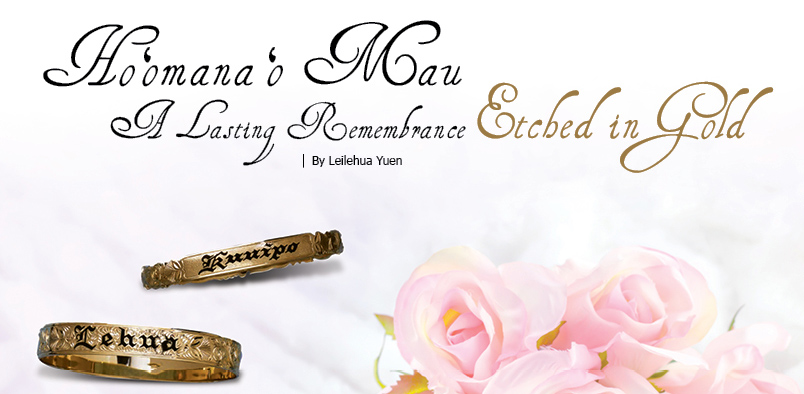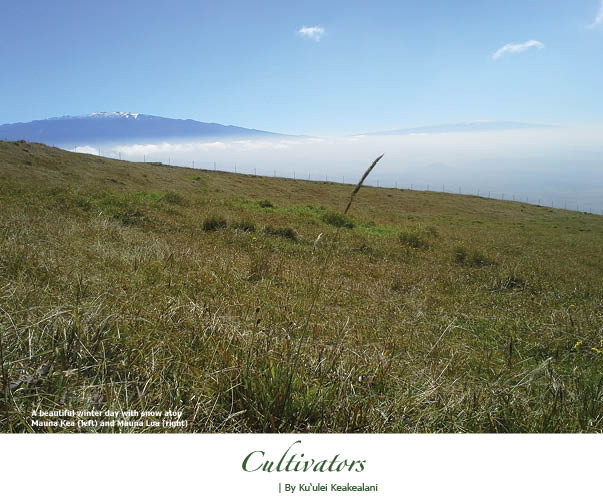
Ho‘omana‘o Mau: A Lasting Remembrance Etched in Gold
 The Hawaiian Islands have neither native metals nor enameling technology. So how did enameled gold bangles become traditional ornamentation for Hawaiians?
The Hawaiian Islands have neither native metals nor enameling technology. So how did enameled gold bangles become traditional ornamentation for Hawaiians?
Ornaments of shell, bone, teeth, wood, feathers, and fiber have been found, which indicate that Hawaiian people have enjoyed jewelry since our ancestors first began to populate these islands. As different groups migrated to the islands, tastes expanded and new styles were added to the cultural jewelry box.
One of the many changes brought to Hawai‘i after the fateful arrival of Captain Cook in 1778, was the introduction of new materials and motifs in fashion and art. As the political and cultural landscape changed, so did the artistic and sartorial.
In 1792, Britain’s Captain George Vancouver made friendly overtures to Pai‘ea Kamehameha, who by then was ruling much of the island chain. Vancouver set the foundation for a deep and lasting friendship with Great Britain. Pai‘ea Kamehameha ruled as a war chief consecrated under the old gods, and the political structure of the islands remained similar to the preceding eras. After his death in 1819, a tsunami of change swept the islands. Among those changes was the development of a modern monarchy, modeled similarly to the English crown. Both Hawai‘i and England were island nations as well as monarchies, and personal and political friendships developed between them.
The new Hawaiian monarchy quickly developed a taste for English and European fashion, especially deriving inspiration from the British Isles. Hawai‘i’s King Alexander Liholiho, Kamehameha IV, and Queen Emma were friends of Britain’s Queen Victoria and her husband, the Prince Consort, Albert. Queen Victoria stood godmother to the Hawaiian royals’ son, Prince Albert Edward Kamehameha, born in May of 1858. Sadly, the Hawaiian prince died in 1862, at only four years of age, a year after the death of his royal namesake, Albert, Prince Consort of England. The following year, the Hawaiian king died. The two queens who had been joined through politics supported each other in their grief, and remained fast friends for life.
Both of the royal women took to mourning dress. Jewelry worn during mourning was quite simple compared to the elaborate jewel-encrusted confections of happier times. The widowed Queen Victoria favored engraved gold bands with black enamel mottos of remembrance.
The little prince had been beloved by all Hawai‘i, and the entire kingdom mourned. Lydia Lili‘u Kamaka‘eha Pākī, a high ranking chiefess related to the king and frequently at court, had lost several family members, including her hānai parents, in the previous years. A young woman of British leanings and taste, she followed Queen Victoria’s fashion, and had bracelets like the British monarch’s commissioned for herself.
A slender bracelet with the motto, Hoomanao Mau, “Lasting Remembrance” (modern writing Ho‘omana‘o Mau) appears in many photos of her from 1862 on, including one taken in her early twenties, and some taken shortly before her death. Another bracelet was engraved R. Naiu (modern writing R. Nā‘iu), possibly in remembrance of the King and his heir, “R.” being a standard abbreviation for the Latin “Rex,” and “Regina,” respectively, “King,” and “Queen,” or their plurals.
As “Naiu” is a plural meaning “the royal ones,” or “the sacred ones,” it seems likely that the bracelet commemorated Hawai‘i’s late royals. However, without documentation from Lydia herself, this is speculation. In any case, other ranking and upperclass women of Hawai‘i soon followed suit.
Lydia’s brother was to become King David Kalākaua in 1874. When he proclaimed her his heir, he changed her name to Lili‘uokalani.
The Victorian bangles again became prominent fashion statements when Kalākaua’s Queen, Kapi‘olani traveled to England for Queen Victoria’s 1887 Golden Jubilee. Crown Princess Lili‘uokalani traveled with her Queen to act as interpreter. Although Kapi‘olani could understand English, she preferred to speak in Hawaiian. The Hawaiian Royals were seated with Queen Victoria and shown all due respect. Among the gifts Victoria presented them were the classic bangles, carved and enameled with their names.
On returning home, the women ordered bracelets made for several close friends and family members. Soon, all Hawai‘i’s ladies of fashion were wearing their own.
The bangles remain popular today. They are given to commemorate special occasions such as birthdays, baptisms, graduations, weddings, anniversaries, and to remember a loved one. Often, a mother or grandmother will have a bracelet made to celebrate the birth of each child. The bracelet is engraved with the child’s name. When the girl grows up and marries, the bracelet is given to her. If the child is a boy, it is given to his bride.
Beloved heirlooms, each bracelet holds precious memories that may date back generations. Some, even to those original remembrances of royalty. ❖
Jewelery photos courtesy Lehua Jewelers
Contact writer Leilehua Yuen
Bibliography
De La Cruz, Linda; Midweek
Foro Dinastias
Hawai‘i Digital Newspapers Project
Lili‘uokalani, Hawai‘i’s Story by Hawai‘i’s Queen; Boston; Lee and Shephard
Shimabukuro, Betty; Honolulu Star-Bulletin
Young, Peter; Ho‘okuleana


